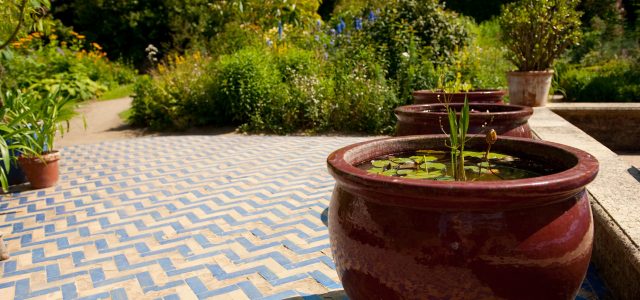
THE WONDER OF WATER GARDENS
A water garden opens up a new world of planting in the garden, but before you start, decide what size and design is best for you
A smaller water garden in a container may be a better fit for your lifestyle and pocket and still gives you the soothing beauty and colour of water plants.
If you are thinking of an in-ground pond it’s often best to seek professional help. A natural-looking water garden should have sloped sides with planting terraces that step down toward the deepest area of the pond. This allows you to have a range of plants and create different habitats. A depth of about 1m (3ft) is usually necessary to ensure that the pond doesn’t freeze solid during the winter.
For something on a smaller scale, consider a patio water garden. If you are using a large sized terracotta pot then you will need to plug the drain hole with a rubber or cork stopper and pond sealant. Other water feature containers could be old Belfast basins and water troughs or half wooden barrels – they just need to be waterproof and leak free which is easy to achieve with a plastic liner.
You can plant several types of aquatic plants in one container but if the plants you choose grow better at different water depths then plant them on a brick or small upturned clay pot in the water to raise them to the right level. Three plants is normally plenty in a 45cm or 60cm pot (1.5ft or 2ft) so you can still see plenty of open water. Try and have a mix of:
Underwater plants – these grow entirely submerged and are good at keeping algae at bay. The pretty Water Violet is a British native plant with white-mauve flowers.
Floaters – their root system hangs down in the water and they are also good algae deterrents. Frogbit is also a native plant, with small round pale green leaves and small white flowers.
Water lilies – they have their root systems anchored at the bottom of the water whilst the leaves and flowers float on the top. Rubra is a miniature water-lily with small rounded leaves and slightly fragrant, deep rose-pink cupped flowers that flower through to September.
WHAT THE EXPERTS SAY
This is the time when autumn establishes itself in the garden but that doesn’t mean it’s time to let it all go to seed – far from it as the experts point out:
If you haven’t done already plant up containers for interest, using cyclamen, heathers, heucheras and other colourful bedding plants. You can also plant prepared hyacinth bulbs in pots or hyacinth glasses, for fragrant indoor flowers at Christmas. In the garden, rake thatch from lawns and aerate well-trodden areas by spiking with a garden fork, and re-seed bare patches. Put netting across ponds to stop autumn leaves falling in and rotting and water autumn-flowering asters regularly to deter mildew.
Gardeners’ World

